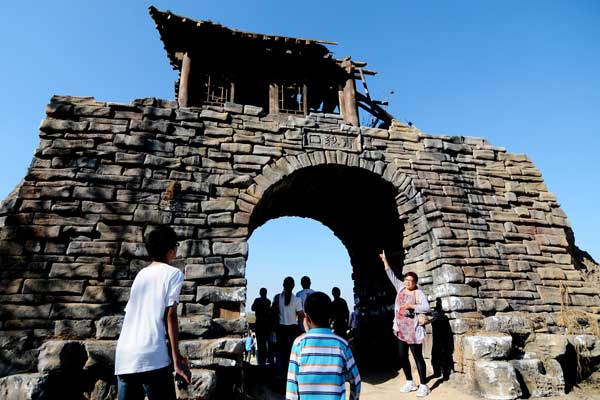Mo Yan's Nobel win brings village a change of plot
Updated: 2013-10-12 00:44
By ZHAO RUIXUE in Gaomi, Shandong province (China Daily)
|
|||||||||||
Chinese people had never paid more attention to the annual Nobel literature award — which on Thursday went to Canadian writer Alice Munro — than they did last year when Mo Yan became China's first winner of the prize.
One year on, and the ripple effect has not subsided. Tourists continue to flock to Mo's home village in Gaomi, Shangdong province, which has been transformed since the author was catapulted to top place in the literary world.
 |
|
Tourists visit the set of a TV series based on Red Sorghum Clan, one of Mo Yan's novels, in Gaomi, Shandong province, during the National Day holiday.[WANG HAIBIN / FOR CHINA DAILY] |
Visiting the village is to walk into the world he created in Red Sorghum Clan, one of his best-known novels, adapted for the award-winning film Red Sorghum by acclaimed director Zhang Yimou in 1987.
Some 210 hectares of red sorghum is ready for harvesting, recalling this scene Mo depicted in the novel:
"In the deep autumn of the eighth month under a high, magnificently clear sky, the land is covered by sorghum that forms a glittering sea of blood. When the sun comes out, the surface of the sea shimmers, and heaven and Earth are painted with extraordinarily rich, extraordinarily majestic colors."
Locals have planted the sorghum for the ongoing shooting of the novel's TV adaptation starring actress Zhou Xun, in similar fashion to 1987 when Zhang's film was shot. But while the sorghum fields disappeared after the film was made, this time they may remain.
"We have signed long-term contracts to sell sorghum to wine producers," said Zhang Xinfu, head of Xianjia village, administered by the Jiaohe River Shugang Logistics Area.
Mo Yan's hometown is in the area.
"Dozens of wine producers came to discuss the sorghum business after Mo Yan won the prize," said Zhang, who set up the Gaomi Dongbei Township Red Sorghum Cooperative early this year.
Zhang said the wine producers promised to pay a satisfactory price for the sorghum.
Chu Hongpeng, deputy director of the Jiaohe River Shugang Logistics Area committee, said about 10,000 people visited Mo's old house and the red sorghum fields every day during the week-long National Day holiday from Oct 1 to 7.
Chu said a typical tourist route includes Mo's house, the sorghum fields, the shooting base for the Red Sorghum TV series, and several scenes in Mo's novels, such as Ping'anzhuang village church.
Guan Moxin, Mo's elder brother, said, "Thousands of tourists came to visit the house every day during the National Day holiday," adding that he had to keep the premises open until 8 pm.
Walls have been refurbished although Mo has repeatedly declined local government repair offers.
A plank bearing the words "Mo Yan's Old House" and a Lunar New Year painting in the flapping-ash style that represents a local folk art listed as a national intangible heritage, hang on the wall.
In front of the house stand booths where Mo's books and local folk arts are sold, including clay sculptures and paper-cuts.
The makers of the film and TV series are also cashing in on Mo's Nobel Prize success, even though adaptations face challenges from audiences' high expectations.
One example is the TV adaptation of Red Sorghum Clan that tells of the struggles of three generations of a rural family between 1923 and 1976, a time of great upheaval.
Although believing the story was ideal for a good TV drama, director Zheng Xiaolong admitted coming under great pressure.
"Sometimes I didn't sleep for days," he said on the set in Gaomi.
Related Stories
Author Alice Munro wins Nobel 2013-10-11 07:25
US trio wins Nobel chemistry prize 2013-10-10 07:25
Belgian, British scientists share 2013 Nobel Prize in Physics 2013-10-09 16:14
Winners of Nobel Prize in Physiology or medicine 2013-10-08 07:18
Today's Top News
China mulls adjusting rules on bank liquidity
Currency swap signed with the EU a 'landmark'
Migrant boat sinks off Sicily
Obama meets with Republicans
OPCW wins Nobel Peace Prize
Yuan clearing bank in sight
Trending news across China on Oct 11
Deepened co-op in East Asia urged
Hot Topics
Lunar probe , China growth forecasts, Emission rules get tougher, China seen through 'colored lens', International board,
Editor's Picks

|

|

|

|

|

|





